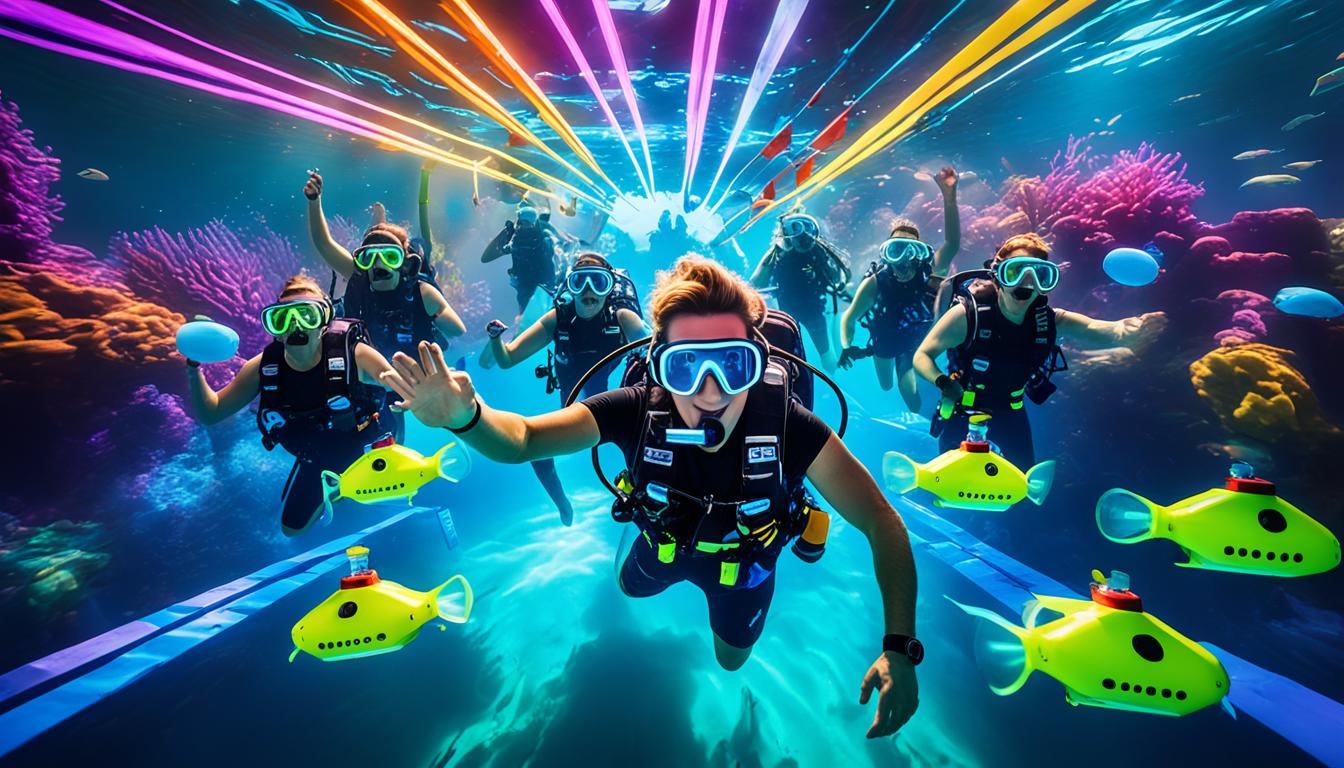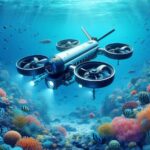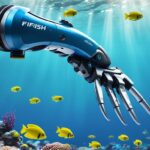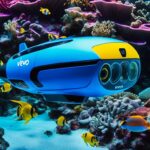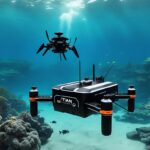Welcome to the new era of marine discovery, where technological advancements are revolutionizing the way we explore the depths of the ocean. In this article, we will delve into the world of underwater drones and traditional diving, discussing how these methods are transforming marine research and ocean exploration.
Underwater drones, also known as underwater robots or remotely operated vehicles (ROVs), have seen a remarkable rise in popularity in recent years. These advanced pieces of underwater technology have opened up a whole new realm of possibilities for marine exploration, allowing scientists and researchers to access and study areas that were previously inaccessible.
But what about traditional diving? The human touch that divers bring to marine research and exploration cannot be underestimated. With their unique experiences and observations, traditional diving offers a level of insight that cannot be replicated by technology alone.
Both underwater drones and traditional diving have their advantages and limitations. While underwater drones offer the power and efficiency of collecting data and capturing stunning underwater photography and videography, traditional diving provides the human element and a hands-on approach to marine research.
Through collaborative efforts and technological advancements, underwater drones and traditional diving can work in harmony to enhance our understanding of the ocean. Together, they have the potential to unlock marine secrets, uncover new discoveries, and conserve marine life for future generations.
In the sections to follow, we will explore the capabilities of underwater drones, compare them to traditional diving, discuss their applications in marine research, and delve into the challenges and limitations they face. We will also look beyond marine research and highlight the broader applications of underwater drone technology in various industries.
Key Takeaways:
- Underwater drones and traditional diving are transforming marine research and ocean exploration.
- Underwater drones offer new possibilities in accessing and studying previously inaccessible areas.
- Traditional diving brings a unique human touch to marine research and exploration.
- Both methods have advantages and limitations and can complement each other in collaborative efforts.
- Underwater drone technology has applications beyond marine research in industries such as environmental monitoring and infrastructure inspections.
- Challenges such as depth limitations and battery life need to be addressed for underwater drone advancements.
The Rise of Underwater Drones
The use of underwater drones has been steadily increasing in the field of marine research, revolutionizing the way we explore and understand the depths of the ocean. With advancements in underwater technology and robotics, underwater drones have become invaluable tools for various applications underwater.
Applications of Underwater Drones
Underwater drones find extensive applications in collecting data and conducting research in areas that were previously inaccessible to humans. They are used in:
- Environmental Monitoring: Underwater drones are deployed to assess water quality, track marine biodiversity, and monitor ecosystem health.
- Archaeological Surveys: These drones aid in exploring and documenting submerged archaeological sites, providing valuable insights into the past.
- Marine Biology Research: Underwater drones assist scientists in studying marine life behavior, migration patterns, and assessing the impact of climate change on aquatic ecosystems.
- Underwater Inspections: They are used for inspecting infrastructure such as oil rigs, pipelines, and underwater structures, reducing the need for divers and ensuring safety.
- Search and Rescue Operations: Underwater drones equipped with sonar systems help in locating underwater wreckage and missing persons.
By harnessing the capabilities of underwater drones, researchers are able to gather accurate data, explore remote underwater locations, and monitor marine environments without putting human divers at risk.
Traditional Diving: The Human Touch
When it comes to marine exploration, traditional diving offers a unique and invaluable human touch that cannot be replicated by underwater drones. While underwater drones have revolutionized marine research with their advanced technology and capabilities, there are distinct benefits that traditional diving brings to the table.
One of the major advantages of traditional diving is the personal connection and firsthand experience that divers have with the underwater environment. Unlike underwater drones, divers can immerse themselves fully in the marine ecosystem, interacting with marine life, feeling the currents, and observing the delicate balance of the underwater world.
Benefits of Traditional Diving
The benefits of traditional diving go beyond the sensory experience. Divers have honed their skills over years of training, allowing them to navigate challenging underwater terrains and collect data in real-time. They can make on-the-spot observations, adjusting their exploration plans based on their findings. This adaptability and spontaneity give traditional divers a significant advantage in certain research scenarios.
Furthermore, traditional diving provides an opportunity for divers to develop a deep understanding of specific marine environments. Through repeated dives in the same location, divers can identify patterns, seasonal changes, and subtle transformations that might elude the lens of an underwater drone. This keen observation allows them to contribute valuable insights to scientific studies and conservation efforts.
Comparison Between Underwater Drones and Traditional Diving
While traditional diving offers unparalleled firsthand experiences and observational skills, underwater drones have their own set of advantages in marine exploration. Let’s compare the two methods side by side:
| Traditional Diving | Underwater Drones |
|---|---|
| Personal connection and immersion in the marine environment | Ability to access hard-to-reach or dangerous areas |
| Real-time observation and data collection | High-quality visuals and media capture |
| Adaptability and spontaneity in exploration | Extended underwater operation with minimal human intervention |
| Deep understanding of specific marine environments | Efficient data collection over larger areas |
As we can see, both traditional diving and underwater drones offer unique advantages in different aspects of marine exploration. While divers bring the human touch and real-time adaptability, underwater drones excel in accessing inaccessible areas and capturing high-quality visuals. It is the combined use of both methods that can truly elevate marine research to new heights.
Next, we will dive deeper into the capabilities and applications of underwater drones, exploring their power to capture stunning underwater photography and videography.
The Power of Underwater Drones
Underwater drones have revolutionized the field of marine exploration with their remarkable capabilities. One area where these technological advancements shine is in underwater photography and videography. With the ability to capture stunning visuals beneath the surface, underwater drones have opened up a whole new world of underwater imaging.
Using advanced imaging systems and high-definition cameras, underwater drones allow researchers, photographers, and filmmakers to document the mesmerizing beauty of the underwater realm like never before. These drones can capture intricate details, vibrant colors, and unique perspectives that were once only accessible to skilled divers.
Through technological advancements, underwater drones now possess the ability to produce professional-quality visuals, making them invaluable tools for various applications.
| Benefits of Underwater Drone Photography and Videography |
|---|
| 1. Scientific Exploration: Underwater drones capture images and videos that aid in the study of marine life and ecosystems, contributing to a deeper understanding of our oceans. |
| 2. Environmental Conservation: By documenting underwater habitats and the impact of human activities, underwater drone imagery helps raise awareness and promote conservation efforts. |
| 3. Underwater Filmmaking: With their ability to capture stunning visuals, underwater drones are widely used in the film industry to create captivating underwater scenes for documentaries, films, and commercials. |
| 4. Recreational Photography: Hobbyists and enthusiasts can now capture breathtaking underwater photos and videos to preserve and share their underwater adventures. |
Additionally, underwater drones equipped with artificial intelligence and advanced imaging software can automate tasks such as image recognition, fish identification, and underwater mapping, streamlining data collection and analysis processes for researchers and scientists.
As the technology continues to evolve, underwater drones are becoming more efficient, compact, and accessible, making them an indispensable tool for professionals and enthusiasts alike.
The Future of Underwater Photography and Videography
“Underwater drones have unlocked a whole new dimension of visual storytelling, helping us explore the mysteries of the deep and capture the beauty that lies beneath the surface.” – Jane Adams, Underwater Photographer
The future of underwater photography and videography holds great promise. With ongoing advancements in imaging technology, underwater drones are poised to capture even more detailed and breathtaking footage. From documenting unexplored regions of the ocean to capturing rare marine species in their natural habitat, underwater drone photography and videography will continue to push the boundaries of visual storytelling and scientific discovery.
Exploring the Depths: Underwater Drone vs. Traditional Diving
When it comes to marine exploration, both underwater drones and traditional diving play important roles in uncovering the mysteries of the deep sea. With technological advancements driving innovation in this field, these two methods offer unique advantages and limitations in their approach. Let’s take a closer look at the comparison between underwater drones and traditional diving and explore how technological advancements have revolutionized marine exploration.
The Advantages of Underwater Drones
Underwater drones have emerged as powerful tools in marine research due to their ability to access remote and hazardous areas with ease. These autonomous devices can capture high-resolution images and videos of underwater environments, providing researchers with valuable data without putting human divers at risk. Underwater drones are equipped with advanced sensors and cameras, allowing for efficient data collection and extensive mapping of underwater landscapes. They offer a cost-effective and time-efficient alternative to traditional diving, making them indispensable in marine exploration.
The Human Element of Traditional Diving
Traditional diving, on the other hand, offers a unique perspective and a more hands-on approach to marine research. The presence of a human diver allows for real-time observations, immediate adjustments, and subjective insights that cannot be replicated by unmanned devices. With their trained eyes and expert knowledge, divers can make crucial observations, identify delicate species, and provide a deeper understanding of marine ecosystems. Additionally, traditional diving allows for direct physical interaction with underwater environments, enabling tasks such as sample collection or equipment maintenance.
Underwater drones and traditional diving each have their own strengths, and a combination of both methods can lead to more comprehensive marine research and exploration.
Comparing the Advancements
In recent years, technological advancements have significantly enhanced both underwater drones and traditional diving, pushing the boundaries of marine exploration. Underwater drones now have more sophisticated sensors, improved maneuverability, longer battery life, and higher image and video resolutions. These advancements have expanded their capabilities and made them more accessible to researchers. Traditional diving techniques have also benefited from technological advancements, with advancements in diving equipment, safety protocols, and communication systems, ensuring divers can push deeper and stay safer for longer durations.
To better understand the differences between underwater drones and traditional diving, here’s a comprehensive comparison:
| Aspect | Underwater Drones | Traditional Diving |
|---|---|---|
| Access to remote or hazardous areas | ✓ | ✓ |
| Real-time observations | × | ✓ |
| Subjective insights | × | ✓ |
| Efficient data collection | ✓ | × |
| Cost-effectiveness | ✓ | × |
As the table demonstrates, underwater drones excel in accessing remote or hazardous areas, offering efficiency and cost-effectiveness in data collection. On the other hand, traditional diving provides the advantage of real-time observations and subjective insights, enabling divers to make immediate observations and contribute their expertise to marine research.
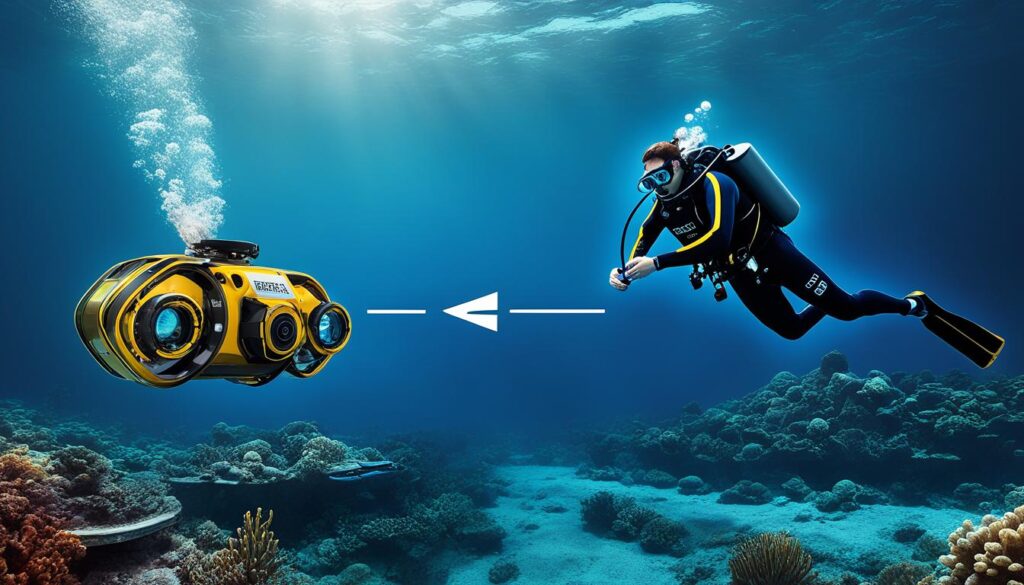
Technological advancements have propelled marine exploration into a new era, where underwater drones and traditional diving work in tandem to unravel the secrets of the ocean. By combining the advantages of both methods, researchers can leverage the technological advancements of underwater drones while benefiting from the expertise and unique insights of human divers. Together, these approaches enhance the accuracy and comprehensiveness of marine research, enabling us to delve deeper into the mysteries of the underwater world.
Uncovering Marine Secrets with Underwater Drones
Underwater drones have revolutionized the field of marine exploration, playing a crucial role in uncovering the secrets hidden beneath the ocean’s surface. With their advanced technology and versatility, these drones have opened up new avenues for marine discovery and underwater exploration.
One of the key applications of underwater drones is in studying marine ecosystems. These drones enable scientists to collect valuable data about underwater flora and fauna, helping us understand the intricate web of life beneath the waves. By capturing high-resolution images and videos, underwater drones provide researchers with a detailed and comprehensive view of marine environments.
Furthermore, underwater drones facilitate more efficient data collection and analysis. They can be equipped with sensors and instruments to measure water quality, temperature, salinity, and other essential parameters. This enables scientists to gather vital information without the need for costly and time-consuming manual sampling.
“The use of underwater drones has transformed our ability to explore and study marine environments. These drones have expanded our understanding of the ocean’s biodiversity and enabled us to make groundbreaking discoveries. They are invaluable tools in unraveling marine secrets.”
In addition to their role in scientific research, underwater drones have also proved instrumental in archaeological exploration. They can investigate underwater archaeological sites, capturing detailed images and videos of submerged artifacts and structures. This allows archaeologists to study and document these sites without disturbing their delicate ecosystems.
Moreover, underwater drones have been utilized in the search for underwater resources, such as oil and gas reserves. These drones can survey vast areas of the ocean floor, providing valuable insights into potential resource-rich regions. By facilitating targeted exploration, underwater drones play a significant role in the sustainable development of underwater resources.
Exploring Uncharted Territories
With their ability to dive to great depths and access remote areas, underwater drones have opened up previously unexplored territories. They can venture into underwater caves, deep trenches, and other challenging environments, allowing scientists to gather data from regions that were once inaccessible. This opens up new opportunities for discovering previously unknown marine species and gaining insights into the mysteries of the deep sea.
Furthermore, underwater drones contribute to efforts to conserve and protect marine ecosystems. By collecting data on the health and biodiversity of underwater habitats, they provide crucial information for conservation initiatives. This knowledge allows policymakers and researchers to make informed decisions and implement effective measures to safeguard our oceans.
| Applications of Underwater Drones in Marine Discovery | Examples |
|---|---|
| Marine environmental monitoring | Collecting data on water quality, temperature, and other parameters to assess the health of marine ecosystems. |
| Marine biological research | Studying underwater flora and fauna to understand biodiversity and ecological interactions. |
| Underwater archaeological exploration | Investigating submerged sites and documenting artifacts and structures. |
| Underwater resource exploration | Surveying the ocean floor to identify potential oil and gas reserves. |
As underwater drone technology continues to advance, the potential for marine discovery and exploration expands. These drones are invaluable tools that enable us to uncover the marine secrets of our planet and gain a deeper understanding of our oceans. By combining technological innovation with scientific expertise, underwater drones are shaping a new era of marine exploration.
Enhancing Marine Research through Technology
The field of marine research has been revolutionized by technological advancements, particularly in the realm of underwater drones. These sophisticated robots have significantly enhanced data collection, monitoring, and analysis capabilities, leading to more accurate and comprehensive findings in marine research.
The Power of Technological Advancements
Technological advancements in underwater drones have brought about a new era of marine exploration. These remarkable robots are equipped with advanced sensors, cameras, and imaging technology, allowing researchers to capture high-resolution images and videos of underwater ecosystems. This has enabled scientists to gain unprecedented insights into marine life and habitats, facilitating a deeper understanding of the world beneath the waves.
Improving Data Collection
One of the key benefits of underwater drones in marine research is their ability to collect vast amounts of data in a relatively short span of time. These robots can be programmed to conduct systematic surveys, capturing data on water temperature, salinity, pH levels, and other crucial parameters. By collecting data over extended periods, researchers can analyze trends and patterns, shedding light on long-term changes in marine environments.
Additionally, underwater drones can reach remote and hazardous locations that are challenging for human divers to access. This opens up new opportunities for exploration in previously uncharted territories, expanding the scope of marine research and uncovering hidden secrets.
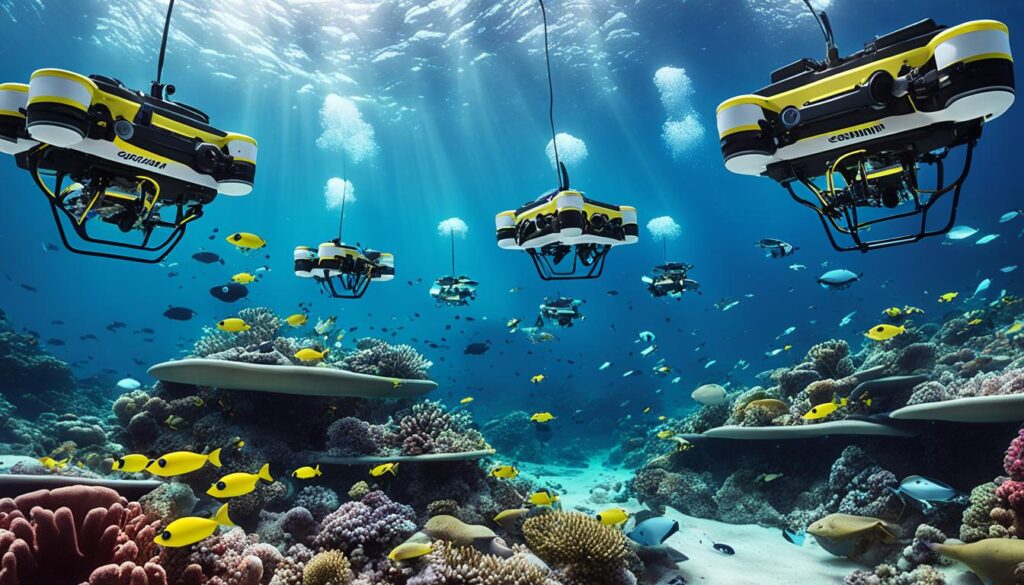
Monitoring and Analysis
Underwater drones play a pivotal role in monitoring marine ecosystems and tracking changes over time. These robots can be deployed for extended periods, capturing continuous footage and collecting data. By comparing data gathered over weeks, months, or even years, researchers gain valuable insights into the dynamics of marine ecosystems and the impact of environmental factors.
Furthermore, advancements in artificial intelligence and machine learning have enabled underwater drones to analyze collected data in real-time. Through sophisticated algorithms, these robots can identify patterns, detect anomalies, and make predictions, aiding researchers in their quest to understand and preserve marine ecosystems.
The Future of Marine Research
With ongoing technological advancements, the capabilities of underwater drones in marine research are expected to expand even further. Improved battery life, increased depths of operation, and enhanced maneuverability are just some areas of development in the pipeline.
It is anticipated that underwater drones will continue to complement traditional diving techniques, allowing researchers to leverage the strengths of both methods. By combining the expertise and observations of human divers with the efficiency and precision of underwater drones, marine research will reach new heights and unlock the mysteries of the deep sea.
As we look to the future, the power of technology in marine research cannot be overstated. Underwater drones are reshaping the way we explore and understand our oceans, facilitating groundbreaking discoveries and driving conservation efforts that will safeguard marine ecosystems for generations to come.
| Benefits of Underwater Drones in Marine Research | Technological Advancements in Marine Research |
|---|---|
| Improved data collection capabilities | Enhanced sensors and imaging technology |
| Access to remote and hazardous locations | Artificial intelligence and machine learning algorithms |
| Real-time monitoring and analysis | Improved battery life and maneuverability |
| Complementary to traditional diving techniques | Advancements on depth limitations |
The Future of Ocean Exploration
As we enter a new era of marine discovery, technological advancements in underwater drone technology are revolutionizing ocean exploration. These cutting-edge devices have the potential to unlock the mysteries of the deep sea, allowing us to explore uncharted territories and conserve marine life like never before.
With the continuous development of underwater drone technology, the future of ocean exploration holds immense promise. These sophisticated devices are equipped with advanced sensors, cameras, and navigation systems, enabling scientists and researchers to dive deeper and gather unprecedented data about marine ecosystems.
Underwater drones offer an unparalleled opportunity to study marine life in its natural habitat, providing insights into underwater ecosystems and species behavior that were once inaccessible.
By utilizing underwater drones, researchers can conduct marine surveys, collect samples, and monitor marine habitats in a non-invasive manner. This allows for a more comprehensive understanding of the complex interactions within marine ecosystems and aids in the preservation and conservation of marine life.
Moreover, the advent of underwater drone technology has opened up new avenues for exploring uncharted territories in the ocean. These autonomous devices can venture into the depths where traditional diving is limited, unveiling hidden wonders and organisms yet to be discovered.
Underwater drones can also contribute to the mapping and surveying of underwater geological features, offering valuable insights into the dynamics of the seabed and potential mineral resources.
Unleashing the Potential of Underwater Drones
As technological advancements continue to propel underwater drone capabilities, exciting possibilities emerge for ocean exploration. Here are some areas where underwater drones are expected to make a significant impact:
- Monitoring and studying deep-sea ecosystems, including fragile coral reefs and unique marine species.
- Assisting in the identification and monitoring of marine protected areas, facilitating the enforcement of conservation measures.
- Conducting underwater archaeological research and mapping submerged cultural heritage sites.
- Aiding in the study of underwater currents, oceanographic research, and climate change analysis.
The future of ocean exploration holds great promise, with underwater drones at the forefront of technological advancements. These versatile devices are poised to transform our understanding of the marine world, contributing to scientific breakthroughs, conservation efforts, and the sustainable management of our oceans.
With every dive, underwater drones bring us closer to unraveling the mysteries of the deep blue, guiding us towards a future where marine discovery knows no bounds.
Challenges and Limitations
While underwater drones have revolutionized marine research through their wide range of applications and technological advancements, they are not without their challenges and limitations. It is important to address these issues to further improve the capabilities and effectiveness of underwater drones in marine exploration.
Depth Limitations
One of the primary challenges faced by underwater drones is their depth limitations. As underwater drones descend into deeper waters, they encounter increased pressure that can exceed their maximum operational limits. This poses a significant challenge in exploring the depths of the ocean where valuable scientific discoveries and marine life thrive.
Battery Life
Another limitation of underwater drones is their limited battery life. The duration of underwater missions is dependent on the capacity of the drone’s battery, which can hinder long-term data collection and exploration. Extended battery life is essential to ensure continuous operation and extended missions, especially in remote or deep-sea environments.
Environmental Impact
While underwater drones offer a non-invasive approach to marine research, their presence and activities can still have an environmental impact. The propulsion systems and equipment of underwater drones may disturb underwater ecosystems, affecting marine life and habitats. It is crucial to develop drones with improved efficiency and minimal disruption to minimize their ecological footprint.
“Overcoming the challenges and limitations of underwater drones is vital for the advancement of marine research and exploration.”
Despite these challenges, ongoing efforts are being made to overcome these limitations through ongoing technological advancements. Researchers and engineers are continuously working to improve the depth capabilities, extend battery life, and reduce the environmental impact of underwater drones.
Technological innovations such as improved materials, advanced battery technologies, and robust navigation systems are being incorporated into underwater drones, enhancing their performance and expanding their potential applications in marine research.
By addressing these challenges and pushing the boundaries of technological possibilities, underwater drones have the potential to revolutionize marine exploration and contribute to significant scientific discoveries in the future.
Collaborative Efforts: Combining Underwater Drones and Traditional Diving
When it comes to marine research and exploration, a collaborative approach that combines the power of underwater drones and traditional diving can yield remarkable results. These two methods, each with their unique advantages and capabilities, complement each other to maximize the benefits for scientific discovery and understanding of the underwater world.
Underwater drones, with their advanced technology and maneuverability, have revolutionized marine research. They can reach great depths, navigate through challenging underwater environments, and collect valuable data with precision. Equipped with high-definition cameras, sensors, and scientific instruments, these drones capture stunning imagery, monitor oceanographic conditions, and analyze various parameters.
“Combining the human element of traditional diving with the efficiency of underwater drones creates a powerful synergy in marine research. It allows us to delve into the depths and collect data while experiencing the awe-inspiring underwater world firsthand.”
However, traditional diving brings a unique human touch to marine research. Divers have the ability to conduct direct observations, study marine organisms in their natural habitats, and make on-site decisions based on their expertise. They can document subtle nuances, behavior patterns, and interactions that might be missed by technology alone.
By integrating underwater drones and traditional diving, researchers can benefit from both approaches. Underwater drones can cover larger areas, collect data continuously, and operate in challenging conditions, while divers can provide deep insights, conduct detailed examinations, and contribute their expert knowledge.
Capturing the Unseen: A Combined Approach
When exploring the depths of the ocean, a collaborative effort between underwater drones and traditional diving can lead to a more comprehensive understanding of marine ecosystems and phenomena. By leveraging the strengths of each method, researchers can conduct thorough investigations, obtain accurate data, and make meaningful scientific contributions.
Underwater drones can be used to conduct initial surveys and identify points of interest in the underwater landscape. They can then assist divers by providing a visual overview of potential areas for further investigation. Once the drones have collected preliminary data, divers can venture into these locations, examining marine life up close, and capturing details that might be missed by remote technology.
This collaborative approach can also enhance the safety of divers. Underwater drones can assess environmental conditions, identify potential hazards, and aid in navigation, ensuring that divers can focus on their research objectives with confidence.
“The combination of underwater drones and traditional diving not only expands our research capabilities, but it also fosters a deeper connection to the marine environment. It allows us to explore the unknown while preserving the delicate balance of the underwater world.”
Expanding Horizons: Applications Beyond Marine Research
Underwater drones have revolutionized marine research with their technological advancements and diverse applications. However, their potential extends beyond scientific exploration. These versatile devices are finding utility in various industries, contributing to environmental monitoring, oil and gas exploration, and underwater infrastructure inspections.
One of the primary applications of underwater drones outside of marine research is environmental monitoring. These devices are equipped with advanced sensors that can collect data on water quality, temperature, and underwater ecosystems. With their ability to navigate challenging underwater environments, underwater drones play a crucial role in monitoring and protecting fragile ecosystems from pollution and other threats.
In the oil and gas industry, underwater drones are being utilized for exploration purposes. These drones can survey underwater oil fields, inspect pipelines, and assess the integrity of underwater infrastructure. By eliminating the need for extensive human involvement, underwater drones enhance operational efficiency and reduce risks in this high-stakes industry.
Underwater infrastructure inspections are another area where these drones are making a significant impact. Whether it’s inspecting dams, bridges, or underwater cables, underwater drones provide a cost-effective and efficient solution. They can capture high-resolution images and video footage, allowing engineers and inspectors to assess the condition of critical underwater structures accurately.
Furthermore, underwater drones are employed in search and rescue operations, aiding in the recovery of lost objects and individuals in bodies of water. Their maneuverability and advanced imaging capabilities make them efficient tools for underwater search missions, increasing the chances of successful outcomes.
The Benefits of Underwater Drone Applications Beyond Marine Research:
Underwater drones have extended the boundaries of marine research, proving their worth in diverse industries. From environmental monitoring to oil and gas exploration and underwater infrastructure inspections, these technological marvels continue to redefine the possibilities in underwater operations.
As underwater drone technology continues to advance, we can expect their applications to expand further, benefiting more industries and disciplines. With their ability to access previously inaccessible underwater environments and provide valuable data, underwater drones are transforming how we interact with and understand our oceans.
| Industry | Application |
|---|---|
| Environmental Monitoring | Water quality assessment, underwater ecosystem monitoring |
| Oil and Gas | Underwater exploration, pipeline inspection, infrastructure assessment |
| Underwater Infrastructure | Dam and bridge inspections, underwater cable assessments |
| Search and Rescue | Recovery of lost objects and individuals in bodies of water |
With the continued advancements in underwater drone technology, we can look forward to even more groundbreaking applications in the future. As these devices become increasingly sophisticated, their role in various industries will only continue to expand, revolutionizing how we explore and interact with the underwater world.
Conclusion
Throughout this article, we have explored the fascinating world of underwater drones and their impact on marine exploration. These remarkable technological advancements have revolutionized the way we study and understand the ocean, opening up new possibilities for marine research and discovery.
By combining the capabilities of underwater drones with the unique insights of traditional diving, we can achieve a comprehensive and holistic approach to marine exploration. Underwater drones provide us with unparalleled access to previously inaccessible areas, allowing us to collect valuable data and uncover marine secrets that were once out of reach. At the same time, traditional diving brings the human touch, allowing divers to observe and experience the marine environment firsthand.
As we look to the future, the prospects for underwater drone technology in marine exploration are truly exciting. With continued advancements, we can expect even greater discoveries and a deeper understanding of our oceans. These underwater drones will not only enhance marine research but also contribute to the conservation of marine life and the sustainable management of our oceans.
In conclusion, the rise of underwater drones has ushered in a new era of marine discovery. Through their technological advancements, underwater drones have transformed the way we explore and study the ocean. Providing us with unprecedented access and insights. By embracing the collaboration between underwater drones and traditional diving, we can unlock the full potential of marine exploration and embark on a journey of discovery that will benefit both science and society.
FAQ
What are underwater drones?
Underwater drones are remotely operated vehicles (ROVs) equipped with cameras and sensors that allow them to explore the underwater environment. They can be controlled from the surface and are used for various applications, such as marine research, underwater photography, and videography.
How do underwater drones work?
Underwater drones are typically controlled using a remote control or a tethered connection. They are equipped with propellers for movement and cameras for capturing images and videos. Some advanced underwater drones also have sensors for collecting data on water conditions and marine life.
What are the benefits of underwater drones compared to traditional diving?
Underwater drones offer several advantages over traditional diving. They can access depths that are unsafe for humans, allowing for exploration in hazardous environments. They also provide a cost-effective and efficient way to collect data and capture imagery underwater.
Can underwater drones replace traditional diving completely?
While underwater drones offer many benefits, they cannot completely replace traditional diving. The human touch and real-time observations that divers provide are invaluable in marine research. Additionally, some underwater environments require the physical presence and flexibility of a human diver.
What are the applications of underwater drones?
Underwater drones have a wide range of applications. They are used in marine research to study marine life and ecosystems. They also study underwater photography and videography to capture stunning images and footage. While in industries such as environmental monitoring, oil and gas exploration, and underwater infrastructure inspections.
What technological advancements have been made in underwater drone technology?
Over the years, there have been significant technological advancements in underwater drone technology. These include improvements in camera quality, longer battery life, enhanced maneuverability, and the integration of advanced sensors for data collection.
What are the limitations of underwater drones?
Underwater drones have some limitations. They are often limited by their depth capabilities and battery life, which restrict the duration and depth of their explorations. They can also be affected by environmental factors such as strong currents and low visibility in murky waters.
Can underwater drones be used for underwater research and exploration beyond marine environments?
Yes, underwater drones have applications beyond marine environments. They can be used for research and exploration in freshwater bodies such as lakes and rivers. They are also useful for monitoring aquatic ecosystems and underwater infrastructure in various industries.
How are underwater drones contributing to marine discovery?
Underwater drones are playing a significant role in marine discovery. They enable scientists to explore previously inaccessible areas of the ocean. Uncovering new species and studying marine ecosystems in greater detail. The data collected by underwater drones helps expand our knowledge of the underwater world.
Are there any ongoing efforts to improve underwater drone technology?
Yes, there are continuous efforts to improve underwater drone technology. Researchers and engineers are working on advancing battery life, enhancing maneuverability and depth capabilities. While developing new sensors and imaging technologies. These advancements aim to further enhance the capabilities of underwater drones in marine research and exploration.
Are there any regulations or restrictions on using underwater drones?
The use of underwater drones is regulated in some areas to protect marine environments and ensure safety. It is important to familiarize yourself with the local regulations. Then obtain any necessary permits or licenses before operating an underwater drone.

